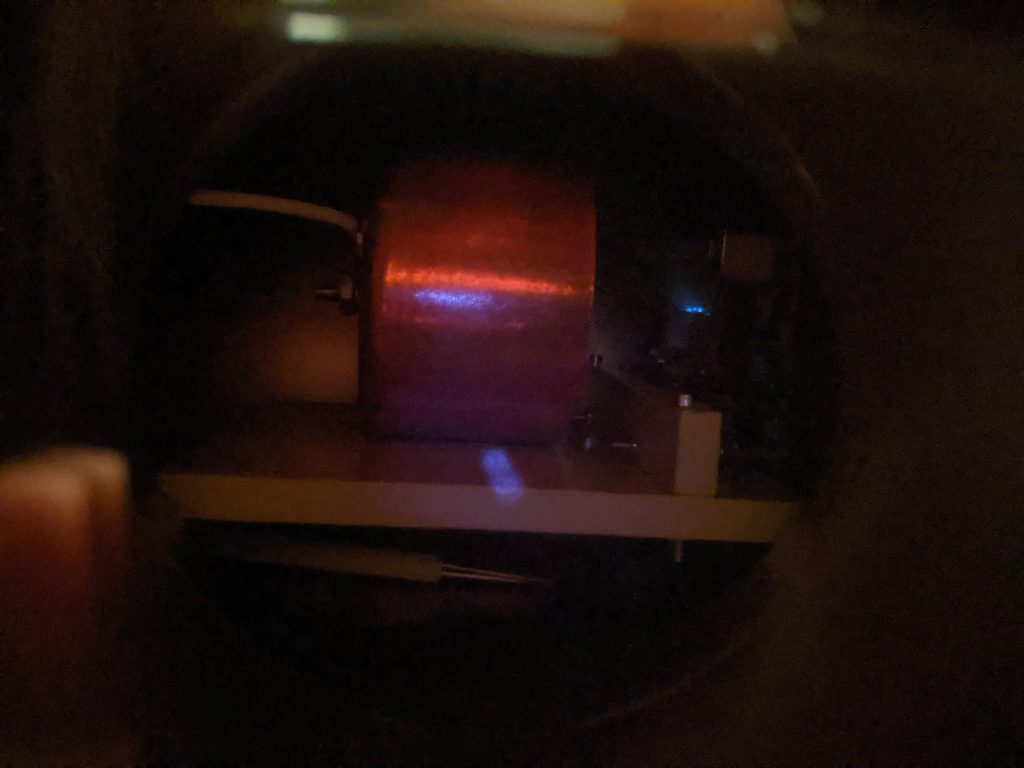In my prior post on the sixth ignition test of the AIS-ILIS1 ionic liquid electrospray thruster, I reviewed the most recent ignition test of the ILIS1, which has been the most successful test to date, truly breaking multiple boundaries in open source electric propulsion! It was during this test, for the first time, that I achieved true, stable multi-site emission across the ridge thruster, as well as the highest peak beam current measured yet, highest thrust, highest ISP, and longest run time yet (full details can be found in the prior post as well as the AIS-TR-015 test report.)
And of course, what EP test would be complete without pictures and video of the thruster plume during operation! Although still very small and low power, the plume is bright enough and clear enough to be seen.

This first video shows the thruster running in a higher mode of emission in bipolar operation. During the video, a polarity transition can be seen, where the thruster switches from positive to negative, therefore changing from a +EMI ion beam to a -BF4 ion beam, extracted from the EMI-BF4 ionic liquid fuel inside the porous glass emitter. Multi-site emission is clearly demonstrated, where turn-on of the porous glass ion emitter is more complete, and operating stably in bipolar mode.
In this next video, the thruster is again seen running in a higher mode of emission. Multi-site emission is clearly demonstrated, where turn-on of the porous glass ion emitter is more complete.
Thruster beam current was measured at 5uA peak at 5kV accelerating voltage, when, factoring in rough initial estimates for PIR mode operation and corrections for real-world inefficiencies, gives us a peak rough estimated thrust of 0.4uN and a peak rough estimated ISP of 4320s. At this point I have undoubtedly hit one of my three target goals of operation, smashing my target ISP of 3000s. Unfortunately, I believe I have hit the limits of emission for this current design, which is currently evolving into the next gen ILIS2. While I am still a ways off from my target thrust of 20uN, with the proper emitter design and some tweaking I should be able to hit these numbers within the next iteration or two. Finally the biggest challenge will be lifetime, solving liquid bridging failures and maintaining stable high-output emission over many hours.
This is a massive achievement for these efforts. I started looking into the possibility of ILIS electrospray last October, when I thought this type of propulsion would be impossible for me to do myself. Through my intensive research, I stumbled across new techniques for bulk-emission macro-scale emitter versions of ILIS that relies on CNC machining rather than conventional MEMS processes and laser micro-machining. I struggled for a long time miniaturizing the electronics and thruster package into something that could be compatible with a PocketQube, and slowly worked my way through the first conceptual designs, with many failures before arriving on the current V6 board. I went through tons of iterations and failed attempts at the switching electronics, which proved to be a massive challenge in the beginning, in both switching and isolating the high voltages in such a compact board.
Actually running and testing this thruster has been a tremendous learning curve as well. I quickly learned the hard way through trial and error better ways to fuel the thruster in vacuum from my first attempts, and moved from immediate catastrophic failure of the thruster to stable bipolar emission for over an hour at a time, while finally measuring beam current with the Faraday cup test stand. This thruster is a completely different beast from my prior PPT builds, and running it is significantly more demanding, requiring very careful control, monitoring, and slow conditioning of the thruster. From this development phase, this is the first time, as far as I am aware, that an ILIS electrospray thruster has been independently designed, built, and successfully operated completely from scratch at home! Considering this technology regularly draws in millions of dollars of research grants and investments, this is a pretty big thing to do out of my basement in my free time!
While phase one of development for the AIS-ILIS series thrusters is about complete, this is only the very beginning. Unlocking higher thrust, this thruster has the potential to be game changing for Cubesats and PocketQubes alike, offering unprecedented access to advance ion thruster technology for nanosats and picosats not prior available before at massive cost reductions.
